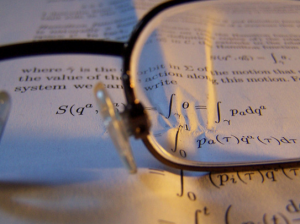As the comedian Louis CK quipped some time ago, “Everything is amazing right now and nobody is happy.” In that instance he was referring to the massive technological improvements that have arisen in the fairly-recent past which served to make our lives easier and more comfortable. Reflecting on the level of benefit that this technology has added to our lives (e.g., advanced medical treatments, the ability to communicate with people globally in an instant, or to travel globally in the matter of a few hours, etc), it might feel kind of silly that we aren’t content with the world; this kind of lifestyle sure beats living in the wilderness in a constant contest to find food, ward off predators and parasites, and endure the elements. So why aren’t we happy all the time? There are many ways to answer this question, but I wanted to focus on one in particular: specifically, given our nature as a social species, much of our happiness is determined by relative factors. If everyone is fairly well off in the absolute sense, you being well off doesn’t help you when it comes to being selected as a friend, cooperative partner, or mate because it doesn’t signal anything special about your value to others. What you are looking for in that context is not to be doing well on an absolute level, but to be doing better than others.
If everyone has an iPhone, no one has an iPhone
To place this in a simple example, if you want to get picked for the basketball team, you’re looking to be taller than other people; increasing everyone’s height by 3 inches doesn’t uniquely benefit you, as your relative position and desirability has remained the same. On a related note, if you are doing well on some absolute metric but could be doing better, remaining content with one’s lot in life and forgoing those additional benefits is not the type of psychology one would predict to have proven adaptive. All else being equal, the male satisfied with a single mate that foregoes an additional one will be out-reproduced by the male who takes the second as well. Examples like these help to highlight the positional aspects of human satisfaction: even though some degree of our day-to-day lives are no doubt generally happier because people aren’t dying from smallpox and we have cell phones, people are often less happy than we might expect because so much of that happiness is not determined by one’s absolute state. Instead, our happiness is determined by our relative state: how good we could be doing relative to our current status, and how much we offer socially, relative to others.
A similar logic was applied in a recent paper by Conroy-Beam, Goetz, & Buss (2016) that examined people’s relationship satisfaction. The researchers were interested in testing the hypothesis that it’s not about how well one’s partner matches their ideal preferences on some absolute threshold when it comes to relationship satisfaction; instead, partner satisfaction is more likely to be a product of (a) whether more attractive alternative partners are available and (b) whether one is desirable enough to attract one of them. One might say that people are less concerned with how much they like their spouse and more concerned with whether they could get a better possible spouse: if one can move up in the dating world, then their satisfaction with their current partner should be relatively low; if one can’t move up, they ought to be satisfied with what they already have. After all, it makes little sense to abandon your mate for not meeting your preferences if your other options are worse.
These hypotheses were tested in a rather elegant and unique way across three studies, all of which utilized a broadly-similar methodology (though I’ll only be discussing two). The core of each involved participants who were currently in relationships completing four measures: one concerning how important 27 traits would be in an ideal mate (on a 7-point scale), another concerning how well those same traits described their current partner, a third regarding how those traits described themselves, and finally rating their relationship satisfaction.
To determine how well a participant’s current partner fulfilled their preferences, the squared difference between the participant’s ideal and actual partner was summed for all 27 traits and then the square root of that value was taken. This process generated a single number that provided a sense for how far off from some ideal an actual partner was across a large number of traits: the larger this number, the worse of a fit the actual partner was. A similar transformation was then carried out with respect to how all the other participants rated their partners on those traits. In other words, the authors calculated what percentage of other people’s actual mates fit the preferences of each participant better than their current partner. Finally, the authors calculated the discrepancy in mate value between the participant and their partner. This was done in a three-step process, the gist of which is that they calculated how well the participant and their partner met the average ideals of the opposite sex. If you are closer to the average ideal partner of the opposite sex than your partner, you have the higher mate value (i.e., are more desirable to others); if you are further away, you have the lower mate value.
It’s just that simple!
In the interests of weeding out the mathematical complexity, there were three values calculated. Assuming you were taking the survey, they would correspond to (1) how well your actual partner matched your ideal (2) what percent of possible real mates out in the world are better overall fits, and (3) how much more or less desirable you are to others, relative to your partner. These values were then plugged into a regression predicting relationship satisfaction. As it turned out, in the first study (N = 260), the first value – how well one’s partner matched their ideal – barely predicted relationship satisfaction at all (ß = .06); by contrast, the number of other potential people who might make better fits was a much stronger predictor (ß = -.53), as was the difference in relative mate value between the participant and their partner (ß = .11). There was also an interaction between these latter two values (ß = .21). As the authors summarized these results:
“Participants lower in mate value than their partners were generally satisfied regardless of the pool of potential mates; participants higher in mate value than their partners became increasingly dissatisfied with their relationships as better alternative partners became available”
So, if your partner is already more attractive than you, then you probably consider yourself pretty lucky. Even if there are a great number of better possible partners out there for you, you’re not likely to be able to attract them (you got lucky once dating up; better to not try your luck a second time). By contrast, if you are more attractive than your partner, then it might make sense to start looking around for better options. If few alternatives exist, you might want to stick around; if many do, then switching might be beneficial.
The second study addressed the point that partners in these relationships are not passive bystanders when it comes to being dumped; they’re wary about the possibility of their partner seeking greener pastures. For instance, if you understand that your partner is more attractive than you, you likely also understand (at least intuitively) that they might try to find someone who suits them better than you do (because they have that option). If you view being dumped as a bad thing (perhaps because you can’t do better than your current partner) you might try to do more to keep them around. Translating that into a survey, Conroy et al (2016) asked participants to indicate how often they engaged in 38 mate retention tactics over the course of the past year. These include a broad range of behaviors, including calling to check up on one’s partner, asking to deepen commitment to them, derogating potential alternative mates, buying gifts, or performing sexual favors, among others. Participants also filled out the mate preference measures as before.
The results from the first study regarding satisfaction were replicated. Additionally, as expected, there was a positive relationship between these retention behaviors and relationship satisfaction (ß = .20): the more satisfied one was with their partner, the more they behaved in ways that might help keep them around. There was also a negative relationship between trust and these mate retention behaviors (ß = -.38): the less one trusted their partner, the more they behaved in ways that might discourage them from leaving. While that might sound strange at first – why encourage someone you don’t trust to stick around? – it is fairly easy to understand to the extent that the perceptions of partner trust are intuitively tracking the probability that your partner can do better than you: it’s easier to trust someone who doesn’t have alternatives than it is to trust one who might be tempted.
It’s much easier avoid sinning when you don’t live around an orchard
Overall, I found this research an ingenious way to examine relationship satisfaction and partner fit across a wide range of different traits. There are, of course, some shortcomings to the paper which the authors do mention, including the fact that all the traits were given equal weighting (meaning that the fit for “intelligent” would be rated as being as important as the fit for “dominant” when determining how well your partner suited you) and the pool of potential mates was not considered in the context of a local sample (that is, it matters less if people across the country fit your ideal better than your current mate, relative to if people in your immediate vicinity do). However, given the fairly universal features of human mating psychology and the strength of the obtained results, these do not strike me as fatal to the design in any way; if anything, they raise the prospect that the predictive strength of this approach could actually be improved by tailoring it to specific populations.
References: Conroy-Beam, D., Goetz, C., & Buss, D. (2016). What predicts romantic relationship satisfaction and mate retention intensity: mate preference fulfillment or mate value discrepancies? Evolution & Human Behavior, DOI: http://dx.doi.org/10.1016/j.evolhumbehav.2016.04.003




Pingback: Absolute Vs Relative Mate Preferences | Pop Psy...